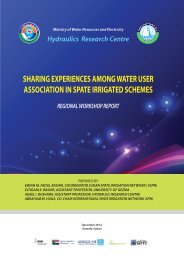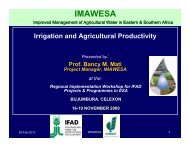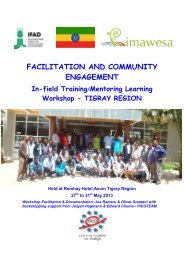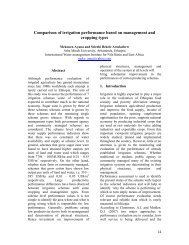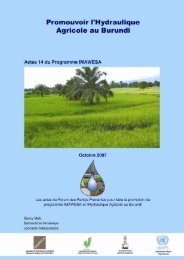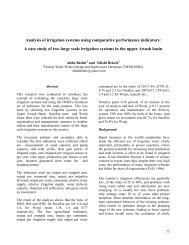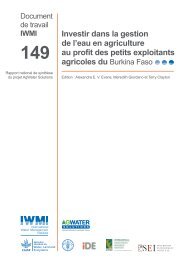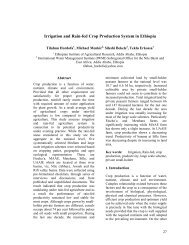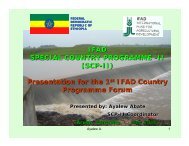Manual - Participatory rapid diagnosis and action ... - FAO.org
Manual - Participatory rapid diagnosis and action ... - FAO.org
Manual - Participatory rapid diagnosis and action ... - FAO.org
You also want an ePaper? Increase the reach of your titles
YUMPU automatically turns print PDFs into web optimized ePapers that Google loves.
PRDA <strong>Manual</strong> 165Learning goalsAt the end of the training, front line extension workers <strong>and</strong> trained farmers:1. have a better underst<strong>and</strong>ing of the four constituents of irrigatedagricultural systems <strong>and</strong> their inter<strong>action</strong>s <strong>and</strong> can independentlydetect major technical problems in the field;2. are able, under the guidance of senior staff, to plan <strong>and</strong> conduct a <strong>rapid</strong><strong>diagnosis</strong> together with counterparts;• have a basic knowledge of participatory methods for analysingperformance, ranking problems, <strong>and</strong> identifying possible solutions;• are able to select suitable tools for <strong>rapid</strong> <strong>diagnosis</strong>;• have the skills <strong>and</strong> attitudes to use these tools effectively;3. are able to process the collected information to identify <strong>and</strong> classifythe main limiting factors <strong>and</strong> possible solutions;• can combine their own <strong>and</strong> others’ knowledge/skills to identifypossible solutions;4. are able, with the assistance of senior staff, to use diagnostic results toformulate an <strong>action</strong> plan with farmers;5. are more responsive to farmers’ needs in schemes targeted during thetraining by:• being aware of the main problems or causes of poor irrigationperformance;• knowing what assistance farmers expect from them to improvesuch performance.In addition to the above, the senior participants6. are able to design <strong>and</strong> coordinate a Rapid Diagnosis <strong>and</strong> ActionPlanning of irrigated agricultural systems;7. can write a report that is accountable <strong>and</strong> reflects Rapid Diagnosis results<strong>and</strong> Action Planning in a way that is easily underst<strong>and</strong>able to outsiders;8. know the main problems faced by farmers <strong>and</strong> front line extensionworkers that can be associated with/attributed to design <strong>and</strong> turnoverprocedures of irrigation schemes.Pedagogic principlesThe pedagogic principles used were based on “learning-by-doing” <strong>and</strong> “learningfrom-each-other.”Classroom training is done before field work to provideguidance <strong>and</strong> after field work to capitalize on the lessons learnt. Both field work<strong>and</strong> classroom training aim to put participants in a position where they have tomobilize knowledge of trainers, farmers <strong>and</strong> key informants to carry out a job



